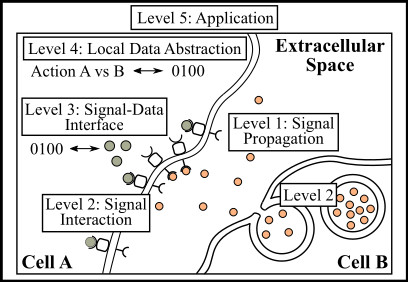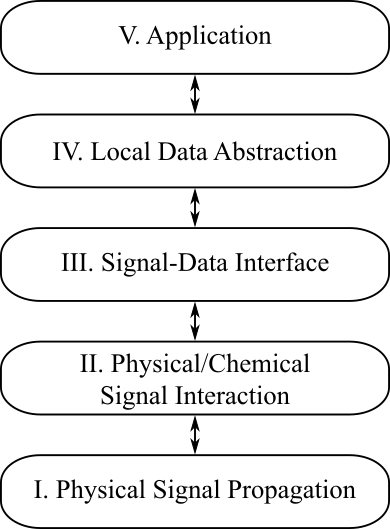
Signal Propagation and Information in Microscale Biological Applications (SIMBA)
Principal Investigator
Christophe Corre (Warwick)

Proposed Framework for Communication in Cell Biology
From Bi et al., 2021
Communication engineering is traditionally based on using electromagnetic signals to transmit information. Inspired by signalling in living cells, the field of molecular communication has emerged to model information transmission using chemical molecules. Molecular communication is radically different in how signals are processed and how they travel over space, but it is still possible to apply communication engineering tools and techniques to design molecular communication systems and optimise their performance.
The state-of-the-art of the molecular communication engineering community focuses on the design of synthetic systems akin to traditional communication technologies such as the Internet. However, molecular signalling plays a key role in how living cells collect and share information to make decisions, so there are many potential opportunities to directly apply molecular communication analysis to biological signalling. This requires an integrated approach to be effective, because the quantity of information available and how cells use that information is quite distinct from how data packets are used in modern telecommunication networks.
The proposed SIMBA project (Signal Propagation and Information in Microscale Biological Applications) will establish a communications engineering framework for describing and controlling cell signalling, behaviour, and decision-making. It will bridge the gap between the field of molecular communication engineering and the understanding of molecular signalling in the life sciences. In particular, the project will facilitate the application of fundamental concepts in signal propagation and communication theory to understand the uncertainty and diversity of responses in living microscopic systems. This understanding will inspire new ways for us to "listen" and "talk" to living cells, thereby supporting new research including the development of health diagnostic tools and facilitating drug discovery.
The project's implementation includes a combination of analytical, simulation, and experimental approaches. A new mathematical framework that divides communication functionality into layers will provide the foundation for all other tasks. Derived results will describe how variations in a cell's behaviour are influenced by the physical imperfections of generating and receiving noisy signals. The framework will be applied to interdisciplinary case studies of bacteria signalling and organ-on-a-chip systems. The bacteria case study will model the emergence of antimicrobial resistance in an environment with different mutants of the S. coelicolor bacterium. The organ-on-a-chip case study will model metabolic regulation between liver and pancreatic cells, as observed in an experimental microfluidic platform. Predictions derived by applying the proposed framework will be tested against simulations and experimental results. The case studies will demonstrate the flexibility of the proposed framework and lead to further engagement within academia and with industry.
Under Review
- Y. Paramalingam, H. Arjmandi, F. Harrison, T. Schiller, and A. Noel, Anisotropic Diffusion Model of Communication in 2D Biofilm, submitted for journal publication, Aug. 2024. (arXiv preprint)
- I. Isik, M. Rezaei, and A. Noel, Single Input Multi Output Model of Molecular Communication via Diffusion with Spheroidal Receivers, submitted for journal publication, May 2024. (arXiv preprint)
- H. Arjmandi, C. Corre, H. Jahangir, and A. Noel, DeepGEEP: Data-Driven Prediction of Bacterial Biofilm Gene Expression Profiles, submitted for journal publication, Nov. 2023. (bioRxiv preprint)
Journal Publications
- H. Arjmandi, K. Kanebratt, L. Vilén, P. Gennemark, and A. Noel, 3D Cell Aggregates Amplify Diffusion Signals, PLOS ONE, vol. 19, no. 9, p. e0310109, Sep. 2024. (bioRxiv preprint)
- M. Rezaei, H. Arjmandi, M. Zoofaghari, K. Kanebratt, L. Vilén, D. Janzén, P. Gennemark, and A. Noel, Spheroidal Molecular Communication via Diffusion: Signaling Between Homogeneous Cell Aggregates, IEEE Transactions on Molecular, Biological, and Multi-Scale Communications, vol. 10, no. 1, pp. 197-210, Mar. 2024. (arXiv preprint)
Conference and Abstract Publications (with official proceedings)
- I. Isik, H. Arjmandi, C. Corre, and A. Noel, Biophysical Model for Signal-Embedded Droplet Soaking into 2D Cell Culture,” in Proc. ACM NanoCom 2023, 6 pages, Sep. 2023. [Open Access] (arXiv preprint)
- A. Noel and H. Arjmandi, “On the Order Statistics of Chemical Kinetics and Their Role in Molecular Communication,” in Proc. ACM NanoCom 2023, 2 pages, Sep. 2023. [Open Access]
- Y. Paramalingam, H. Arjmandi, and A. Noel, “Role of Channel Capacity in Biofilm,” in Proc. ACM NanoCom 2023, 2 pages, Sep. 2023. [Open Access]
- H. Arjmandi, M. Zoofaghari, M. Rezaei, K. Kanebratt, L. Vilén, D. Janzén, P. Gennemark, and A. Noel, Diffusive Molecular Communication with a Spheroidal Receiver for Organ-on-Chip Systems, in Proc. IEEE ICC 2023, May 2023. (arXiv preprint)
Conference and Abstract Presentations (without official proceedings)
- N. Briantceva, A. Noel, and M.-S. Alouini, Bi-Directional Spheroidal Molecular Communication in Flowing Media, presented at MolCom 2024, 2 pages, Apr. 2024.
- M. Rezaei and A. Noel, Spheroidal Receiver with Non-Uniform Porosity, presented at MolCom 2024, 2 pages, Apr. 2024.
- M. Rezaei, H. Arjmandi, M. Zoofaghari, K. Kanebratt, L. Vilén, D. Janzén, P. Gennemark, and A. Noel, Organ(oid)-on-Chip Amplifies Diffusion Signals, presented at BalkanCom 2023, Jun. 2023.
- Y. Paramalingam, H. Arjmandi, and A. Noel, Biofilm Water Channel Network Model for Bacterial Communication, presented at MolCom 2023, 2 pages, Apr. 2023.
- H. Arjmandi, M. Zoofaghari, M. Rezaei, K. Kanebratt, L. Vilén, D. Janzén, P. Gennemark, and A. Noel, Organ(oid)-on-Chip Amplifies Diffusion Signals, presented at MolCom 2023, 2 pages, Apr. 2023.
- Y. Paramalingam, H. Arjmandi, and A. Noel, Biofilm Water Channel Network Model for Bacterial Communication, presented at Physics of Life 2023 Conference, 1 page, Mar. 2023.
- H. Arjmandi, D. Janzén, P. Gennemark, and A. Noel, Do Cells Perceive Diffusion Noise?, presented at MolCom 2022, 2 pages, Jul. 2022. (YouTube recording)






